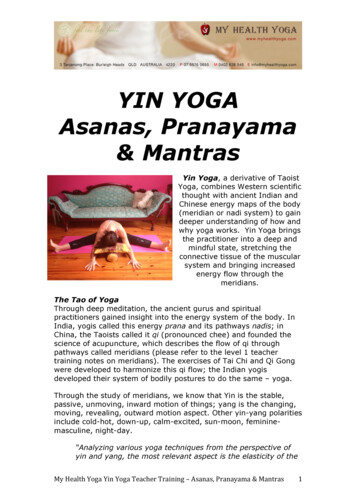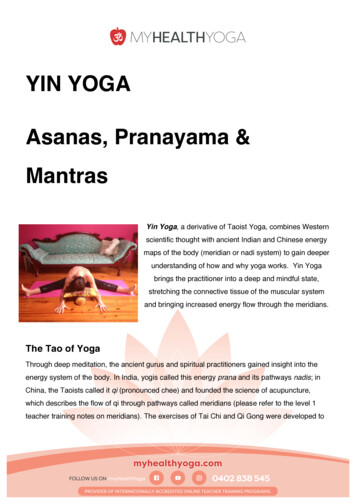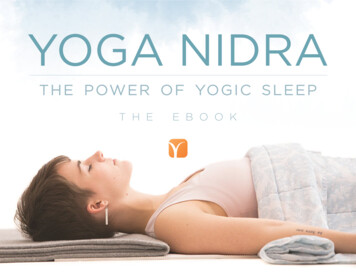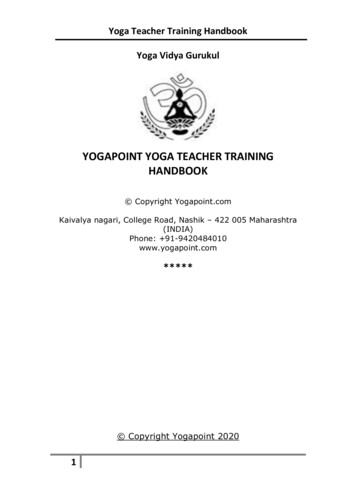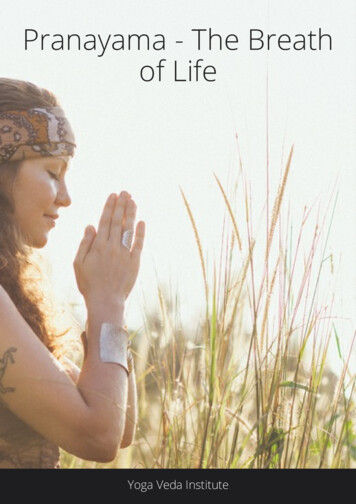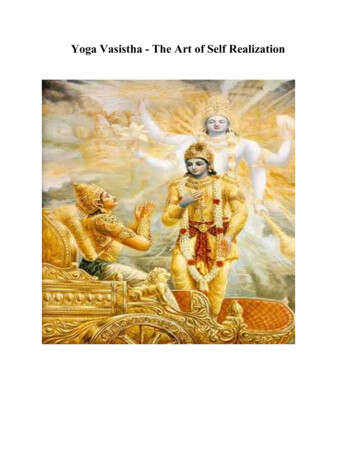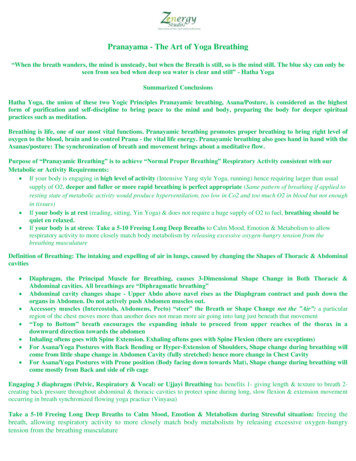
Transcription
Pranayama - The Art of Yoga Breathing“When the breath wanders, the mind is unsteady, but when the Breath is still, so is the mind still. The blue sky can only beseen from sea bed when deep sea water is clear and still” - Hatha YogaSummarized ConclusionsHatha Yoga, the union of these two Yogic Principles Pranayamic breathing, Asana/Posture, is considered as the highestform of purification and self-discipline to bring peace to the mind and body, preparing the body for deeper spiritualpractices such as meditation.Breathing is life, one of our most vital functions. Pranayamic breathing promotes proper breathing to bring right level ofoxygen to the blood, brain and to control Prana - the vital life energy. Pranayamic breathing also goes hand in hand with theAsanas/posture: The synchronization of breath and movement brings about a meditative flow.Purpose of “Pranayamic Breathing” is to achieve “Normal Proper Breathing” Respiratory Activity consistent with ourMetabolic or Activity Requirements: If your body is engaging in high level of activity (Intensive Yang style Yoga, running) hence requiring larger than usualsupply of O2, deeper and fuller or more rapid breathing is perfect appropriate (Same pattern of breathing if applied toresting state of metabolic activity would produce hyperventilation, too low in Co2 and too much O2 in blood but not enoughin tissues) If your body is at rest (reading, sitting, Yin Yoga) & does not require a huge supply of O2 to fuel, breathing should bequiet en relaxed. If your body is at stress: Take a 5-10 Freeing Long Deep Breaths to Calm Mood, Emotion & Metabolism to allowrespiratory activity to more closely match body metabolism by releasing excessive oxygen-hungry tension from thebreathing musculatureDefinition of Breathing: The intaking and expelling of air in lungs, caused by changing the Shapes of Thoracic & Abdominalcavities Diaphragm, the Principal Muscle for Breathing, causes 3-Dimensional Shape Change in Both Thoracic &Abdominal cavities. All breathings are “Diphragmatic breathing”Abdominal cavity changes shape - Upper Abdo above navel rises as the Diaphgram contract and push down theorgans in Abdomen. Do not actively push Abdomen muscles out.Accessory muscles (Intercostals, Abdomens, Pecto) “steer” the Breath or Shape Change not the ”Air”: a particularregion of the chest moves more than another does not mean more air going into lung just beneath that movement“Top to Bottom” breath encourages the expanding inhale to proceed from upper reaches of the thorax in adownward direction towards the abdomenInhaling oftens goes with Spine Extension. Exhaling oftens goes with Spine Flexion (there are exceptions)For Asana/Yoga Postures with Back Bending or Hyper-Extension of Shoulders, Shape change during breathing willcome from little shape change in Abdomen Cavity (fully stretched) hence more change in Chest CavityFor Asana/Yoga Postures with Prone position (Body facing down towards Mat), Shape change during breathing willcome mostly from Back and side of rib cageEngaging 3 diaphragm (Pelvic, Respiratory & Vocal) or Ujjayi Breathing has benefits 1- giving length & texture to breath 2creating back pressure throughout abdominal & thoracic cavities to protect spine during long, slow flexion & extension movementoccurring in breath synchronized flowing yoga practice (Vinyasa)Take a 5-10 Freeing Long Deep Breaths to Calm Mood, Emotion & Metabolism during Stressful situation: freeing thebreath, allowing respiratory activity to more closely match body metabolism by releasing excessive oxygen-hungrytension from the breathing musculature
Zenergy Breathing Techniques (based on Ujjayi Breathing)This technique is used at the beginning of the class to:1- Freeing the breath, allowing respiratory activity to more closely match body metabolism by releasing excessive oxygen-hungrytension from the breathing musculature (diaphragm, intercostal muscles, abdomens). This help correcting fast shallow breathing thatinappropriately match body metabolism due to body “fight & flight” reaction to stressful situations before the class2- Slowly establish Deep even breath and engage 3 Diaphragms to prepare for more dynamic asana/posture.3- Moving into a Calm meditative state/flow to discover the subtle inner world: Synchronization of breath and movement4- Respiratory activity consistently matches Metabolic Requirements: During Intensive pose: Deeper breathing with inhaling changing shapes of 2 cavities (Abdomen & Chest), exhaling involvecontraction of musculatures surrounding 2 cavities (Diaphragm, Abdomens, Intercostal) During Yin/resting poses: Relax & quiet breathing applies. Inhaling changes shape of abdomen cavity and little change in chestcavity while exhaling is a passive reversal of this process/ passive recoil of diaphragm, very little engagement of accessory musles(intercorstal, abdomens)Preparation: Lying on your back, legs and arms open and falling to sides. Body totally relax and let go of all tensionPut one hand on upper abdominal above navel, left hand on rib cage.Begin to observe your current breathing patternGradually & Slowly deepen your breathing pattern to make it longer and even or inhaling length is equal exhaling lengthThe lower Abdominals (between belly button & pubic) and pelvis floor always slightly engagedStep 1: Engage the Respiration Diaphragm & Pelvis Diaphragm to make the breath deep and evenInhalation Inhale deeply and slowlyKeeping lower abdo & Pelvis Diaphragm slightly engaged to support lower back & spine.Feeling left hand slightly lifting as intercostal muscles contracting & lifting rig cageFeeling right hand lifting slightly (diaphragm lower from above rib cage-nipple level towards belly button, pushing organs inabdomen cavity down and out – changing shape of abdomen cavity). (Do not actively pushing abdominal muscles out)Total chest cavity expands fully 3-dimensionallyExhalation: Exhale deeply and slowlyRight hand/ navel lower down - diaphragm relaxes & goes upLeft hand lower down - intercostal muscles relaxTighten navel further towards lower back to fully engage abdomen and Pull up to engage Pelvis floorTotal chest cavity contracts fully 3-dimensionallyStep 2: Engage Vocal Diaphragm to control the speed (slow down) of breathing Start by making inhale and exhale deep and same length (Result of step 1)Count slowly 1-2-3-4-5 on the inhale and on the exhaleStart learning the exhale:Open your mouth and say “Hhhhaaammmm” at the exhale as though you are whisperingRepeat a few times, feeling the vibration and swirl of air in the back of your throatMove on making the sound “Hhhhaaammmm” keeping your mouth closed on the exhaleCreate a deep breath at the top of your throat behind your nostrils (not at the tip of your nose). Technically you need to controlyour glottisLearn the inhale: Continue with your Ujjayi breathing on the exhale. On the inhale, create the same deep swirling sound
How the Lungs and Respiratory System WorkWithout noticing, you breath 12-20 times per min, 17000 per day, 6 millions breath per year thanks to body's respiratory system.Lungs expand and contract, supplying life-sustaining oxygen to body & removing from it, a waste product called carbon dioxide.The Act of Breathing Breathing starts at the nose and mouth. You inhale air into nose or mouth, air travels down the back of the throat and intowindpipe/trachea. Trachea divides into air passages called bronchial tubes.For your lungs to perform their best, these airways need to be open during inhalation and exhalation & free from inflammationor swelling and excess or abnormal amounts of mucus.The Lungs: as bronchial tubes pass thru lungs, they divide into smaller air passages called bronchioles. The bronchioles end intiny balloon-like air sacs called alveoli. Your body has over 300 million alveoli. Surface of lung roughly as tennis court. Thealveoli are surrounded by a mesh of tiny blood vessels called capillaries. Here, oxygen from the inhaled air passes through thealveoli walls and into the blood.After absorbing oxygen, the blood leaves the lungs and is carried to your heart. Your heart then pumps it through body toprovide oxygen to cells of tissues and organs. As cells use oxygen, carbon dioxide is produced & absorbed into blood. Youblood then carries carbon dioxide back to lungs where it is removed from body when you exhale.Clearing the Air The respiratory system has built-in methods to prevent harmful substances in the air from entering the lung.Hairs in nose help filter out large particles. Microscopic hairs, called cilia, found along air passages & move in a sweepingmotion to keep the air passages clean. But if harmful substances (cigarette smoke), are inhaled, cilia stop functioning properly,causing health problems like bronchitis.Mucus produced by cells in the trachea and bronchial tubes keeps air passages moist and aids in stopping dust, bacteria andviruses, allergy-causing substances, and other substances from entering the lungs.Impurities that do reach the deeper parts of the lungs can often be moved up via mucous and coughed out or swallowed.
Breathing Muscles Anatomy and PhysiologyThe muscles of respiration contributes to inhalation & exhalation by aiding in expansion & contraction of thoracic cavity.1-Principal muscle: Diaphragm A thin, dome-shaped muscle that separates the abdominal cavity from the thoracic cavity.Inhalation: the diaphragm contracts, its centre moves caudally (downward) & its edges move rostrally (upward) thatcompresses abdominal cavity, raises ribs upward & outward - thoracic cavity expand - draws air into the lungs.Exhalation: Diaphragm relaxes, elastic recoil of the thoracic wall causes thoracic cavity to contract, forcing air out of thelungs.Also involved in non-respiratory functions, helping to expel vomit, feces, and urine from the body by increasing intraabdominal pressure, and preventing acid reflux by exerting pressure on the esophagus/foodpipe as it passes through theesophageal hiatus/hole in diaphragm2- Other MusclesSecondary muscles: Intercostal muscles: Three layers of intercostal muscles attached between the ribs important in manipulating the width of the rib cage.External intercostal muscles: most significant in respiration with fibres angled obliquely downward and forward from rib torib. The contraction of these fibres raises each rib toward rib above raising the rib cage assisting in inhalation.Accessory muscles of respiration' assist, but do not play a primary role, in breathing: Neck Muscles - sternocleidomastoid & scalene muscles (anterior, middle and posterior scalene)Others: serratus anterior, pectoralis major and pectoralis minor, trapezius, latissimus dorsi, erector spinae, iliocostalislumborum, quadratus lumborum, serratus posterior superior, serratus posterior inferior, levatores costarum, transversusthoracis, subclaviusOnly used under conditions of high metabolic demand (e.g. exercise) or respiratory dysfunction (e.g. an asthma attack)
Muscles of exhalationQuiet RespirationQuiet breathing: little or no muscle contraction involved in exhalation, driven by elastic recoil of the thoracic wall.Forceful exhalationooWhen Active sports Problem – reduced elasticity of the lungs (in emphysema/ Chronic obstructive pulmonary disease),How: Contraction of the abdominal wall muscles (rectus abdominus, transverse abdominus, external obliquemuscle and internal oblique muscle). These press the abdominal organs caudally (upward) into thediaphragm, reducing the volume of the thoracic cavity. The internal intercostal muscles have fibres that are angled obliquely downward and backward from rib torib. These muscles can therefore assist in lowering the rib cage, adding force to exhalation.‘Forced’ Breathing
Diaphragm causes Shape Changes in Both Chest and Abdomen cavitiesInhalation: Diaphragm contracts, abdomen cavity (like water ballon) changes shape (not volume) by expand upper abdomen. Chest Cavity (like Accordion)increases in volume and shape thus expand 3-dimensionally.Exhalation: Diaphram relaxes/recoils, abdomen cavity (change shape) contracts above push up to chest cavity. Chest Cavity decreases in volume and shape hencecontracts 3-dimensionally.Diaphragm causes both Chest & Abdomen cavities to move simultaneously If the diaphragm’s origin (the base of the ribcage) is stable, and its insertion (the central tendon) is mobile, a diaphragmaticcontraction will cause an expansion of Abdomen “Belly Breath”If the central tendon is stabilized, and the ribs are free to move, a diaphragmatic contraction will cause an expansion of theribcageIf the diaphragm's stabilizing muscles releases (not 100%, some respiratory stabilizing muscles/postural muscles remainactive through all phases of breathing), hence its origin and insertion move freely towards each other, both the chest andabdomen would move simultaneously
How much does your diaphragm actually move?InhaleExhaleIt depends on how deep of a breath you take and what part of the diaphragm you are asking about. The diaphragm is a sheet likedome-shaped muscle (when it is relaxed). Upon contraction, it flattens out and presses down on the abdomen. The net result is anegative inspiratory pressure, which draws air into the lungs.Tidal, resting breathing, results in smaller movements of the diaphragm. While vital capacity breathing (as in a deepdiaphragmatic breath) results in much larger movement - a complete full inhalation.The posterior, or back part of the diaphragm exhibits the greatest excursion: the posterior region moving an average of 10cm between inhalation and exhalation. (MRI studies)The amount of diaphragmatic motion decreases progressively as we come forward w/most anterior portion moving about halfthat of the posterior thus 5cmDiaphragmatic motion decreases by about 1/3 in the sitting position compared to lying on your back.
Inhalation often with Spine Extension & Exhalation with Spine FlexionThe supporting shape changing structure that occupies the back of the body’s two primary cavities - the spine. This is why breathingand spinal movement are so intimately connected: flexion of the spine is the shape change that reduces thoracic volume (exhale)and spinal extension is the shape change that increases thoracic volume (inhale). Additionally, as we shall soon see, themusculature of the breathing mechanism is the musculature of postural support.There are exceptions where you inhale during spine flexion and exhale during spine extension or respiration without changing shapeof the spine
Pranayama - Yoga Conscious Controlled Breathing, Bandha & Core StrengthPranayamic breathing - The science of breath controlWhat is the core: core muscles go well beyond the six-pack abs of the rectus abdominus. Core muscles are a group of about 10muscles that surround the spine, front & back: Abs, Pelvis muscles, back muscles, hip flexors & glutes.Functions of Core strength: Stabilises spine & pelvis to provide power & strength for movement. Improves posture, alleviates back pain & helps to protect back from injury both in and out of our yoga class. Provides platform for advanced yoga poses: ‘engage your core & bandhas to support spine & pelvis. Prolonged sitting, poor posture and pregnancy can all contribute to a weakened core.What are bandhas: The ‘core’ of core strength are bandhas – mula, uddiyana, jalandhara. They act as the base-mula-Pelvis diaphragm, the middle- uddiyana-Respiration diaphragm and the ‘lid’ – jalandhara-Vocaldiaphragm of the core, retaining prana or life force energy. A bandha refers to the coactivation or contraction of muscle groups to provide a lock or seal The base-mula-Pelvis, the middle- uddiyana-Respiration diaphragm are always slightly 30% engaged when inhale and100% when exhale. Bandhas used in yoga to stabilise, strengthen, energise & increase stillness & body awareness 3 major bandhas which correspond to our 3 diaphragms:
Core Muscles to Support Active Conscious Yoga breathing
3 Bandhas/Diaphragms (Vocal, Respiration, Pelvis)Vocal Diaphragm/ Jalandhara Bandha
Respiration Diaphragm/ Uddiyana Bandha
Pelvis Diaphragm / Mula Bandha
Benefits of Long Controlled Deep Breaths to Calm Mood, Emotion & Metabolism during Stressful situationYour body breathes on autopilot. So why worry about how to inhale and exhale when you could be mastering an armbalance? Scientific research is showing that mindful breathing—paying attention to your breath and learning how tomanipulate it is one of the most effective ways to lower everyday stress levels and improve health factors ranging from moodto metabolism. “Pranayama is at once a physical-health practice, mental-health practice, meditation using breath to make yourentire life better.”“There is a very direct relationship between breath rate, mood state & autonomic nervous system state,” The autonomic nervoussystem governs the body’s sympathetic (fight-or-flight) and parasympathetic (rest-and-restore) responses, dialing functions likeheart rate, respiration, and digestion up or down as necessary in response to potential threats. Evolutionarily, this worked as asurvival mechanism, but today’s nonstop barrage of smartphone, emails & news updates trips body’s alarms.Breath changes in response to emotion: When people get panicky and anxious, their breath becomes shallow and rapid,” Activelybringing the breath rate back to normal – “Body metabolism matching rate” can actually change autonomic function and moodstate.” : With each breath, millions of sensory receptors in the respiratory system send signals via the vagus nerve to the brainstem. Fast breathing pings brain at a higher rate, triggering it to activate the sympathetic nervous system, turning up stress hormones,heart rate, blood pressure, muscle tension, sweat production, and anxiety.Slowing breathing induces parasympathetic response, dialing down all of above - relaxation, calm, and mental clarity.Sources:Yoga Anatomy, Leslie Kaminoff athehttps://en.wikipedia.org/wiki/Muscles of pranayama/ -of-the-bandhas/http://www.yinyoga.com/newsletter3 yinside of bandhas.php 2/07/11/ujiayi-breathing-and-bandhas/
Zenergy ExercisesKey principles for Zenergy exercises: Posture (Long Spine, Hip over Knee over Ankle, Soft Knee & Elbow, Soft Relax Face (Eyes, Jaw, Lips, Tongue), Relax Shoulders back & away from Ears, Belly button drawn in towards lower back Inhale in deeply via Nose (Diaphragm down hence belly out, Rib cage expand Front, Back & sides) & Exhale out via Nose (Belly in, Rib Cage down) Control (Mind – Breathing w/ Movement and Body – Slow Controlled Precise Movement engaging All Muscles) Listen to Your Body (Right option, No. Rep, Range of Motion): Burning Muscle Ok - No Pain - Stretch Tight Muscle Yang Yoga- Stress mildly Joints holding still long time (while muscles relax in yin yoga)
Pranayama - The Art of Yoga Breathing “When the breath wanders, the mind is unsteady, but when the Breath is still, so is the mind still.The blue sky can only be seen from sea bed when deep sea wate
